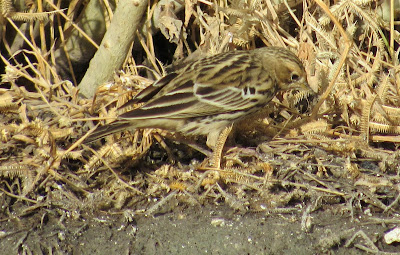Once again, there was considerable change on the previous visit.
One fixture was the five or six blue-cheeked bee-eater which have been around ever since I returned from my summer break.
blue-cheeked bee-eater
We didn't linger so long at the western side of the site as I normally do. We went more directly to the main body of water.
This paid dividends as Mohamed Vall saw his first ever red-throated pipit. It was made easier by the presence of two tree pipit to compare against.
red-throated pipit
It was darkly streaked on its back and the heavily patterned rump was easy to see.
red-throated pipit 2
The three parallel strong streaks at the side of both flanks were also obvious.
red-throated pipit 3
I had recently removed my previous record of red-throated pipit in Mauritania for lack of certainty so this one became a new addition as my total had gone back by one.
It is painful to remove records but you can only be true to yourself.
Eurasian spoonbill 1
Still at the main body of water, we kept on inspecting the waders but nothing unusual appeared.
A Eurasian spoonbill caught our attention though.
Eurasian spoonbill 2
This is a young bird with a pink bill but there is no other resemblance to African spoonbill which is still not on my country list.
I have yet to visit either national park. A trip to Diawling in the south west corner of the country is the best bet to see this species.
This may be organised soon.
Eurasian spoonbill 3
We left the main water relatively quickly this time.
While walking down the sandy road eastward, Mohamed Vall pointed out a raptor just north of the site in a tree.
short-toed eagle 1
It turned out to be a short-toed eagle. This is not the first time this autumn that the site has attracted this species. However, they are not known to winter here. They do winter in large numbers though only 200 kilometres south along the Senegal River.
short-toed eagle 2
On returning back to the main site after our detour, we spent longer than usual in the eastern part where there are small pools with close cover.
A few of the delivery trucks dump their water here rather than at the main pool. It would be a shame if they ever stopped doing that as this creates a different habitat to the main pool which has more water but less tree cover.
northern wheatear
There is often a good mix of passerines in this area and they are not necessarily warblers. Ortolan bunting was seen here again. A deeply coloured northern wheatear was an interesting sight. I suspect it is Greenland or Iceland in origin.
Fulvous babbler
Egyptian vulture
For a second time, Mohamed Vall called me over and for a second time it was for a bird of prey.
This time Mohamed Vall had picked up on a young Egyptian vulture.
This was the first time I had seen one in the Nouakchott area though I had read last year that a tagged one had spent all winter just outside the city. It had moved around quite a bit but by its tracking, it could easily have crossed this site.
blackcap (back) with garden warbler (front)
After this excitement, I moved on to spend time and patience observing warblers in a damp and shaded area.
It was interesting to see the closely related garden warbler and blackcap side by side.
Blackcap though can winter in the Nouakchott area whereas all garden warbler are on passage to go further south.
European reed warbler
Once again the waste water site had plenty of Eurasian reed warbler. The beauty of this site is the ability to see this species in the open. It doesn't have long grass or reeds to hide in.
garden warbler
The warblers were so busy feeding, I found if I just stood still they would forget about me. You can see that I am looking down on this garden warbler because it came so close.
chiffchaff
a close European reed warbler
It wasn't just garden warbler that came up close. It was a privilege to see European reed warbler and blackcap do the same.
female blackcap
I have spent a lot of time this autumn trying (and in the end succeeding) in separating a small number of Iberian chiffchaff from willow warbler.
common chiffchaff with white belly
Some white bellied, lemon vented and lemen supercilium birds that Saturday may also have been Iberian chiffchaff. One certainly looked very good. However without calls it requires considerable photographic effort and I didn't priotise it this time round.
common chiffchaff with yellow belly 2
The bird above was not the one I considered closest. That one had the same features plus lighter legs and less grey tones around the head than the photographed bird.
Overall, it was another good day. I had to wait another week until I birded again. Mohamed Vall and I went to other sites around the city that time and I managed to add another bird to my Mauritanian list. I will blog about that next.
Species at the waste water site
Garganey
Little Egret
Eurasian Spoonbill
Egyptian Vulture
Short-toed Eagle
Spur-winged Lapwing
Kentish Plover
Common Ringed Plover
Ruff
Little Stint
Green Sandpiper
Wood Sandpiper
European Turtle Dove
Laughing Dove
Namaqua Dove
European Scops Owl
Little Swift
Eurasian Hoopoe
Blue-cheeked Bee-eater
Common Kestrel
Southern Grey Shrike
Crested Lark
Sand Martin
Barn Swallow
Willow Warbler
Common Chiffchaff
Iberian Chiffchaff
Eurasian Reed Warbler
Eurasian Blackcap
Garden Warbler
Spotted Flycatcher
Bluethroat
European Pied Flycatcher
Common Redstart
Northern Wheatear
Western Yellow Wagtail
White Wagtail (alba)
Tree Pipit
Red-throated Pipit
Ortolan Bunting
House Sparrow
Sudan Golden Sparrow





















No comments:
Post a Comment